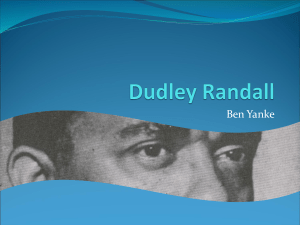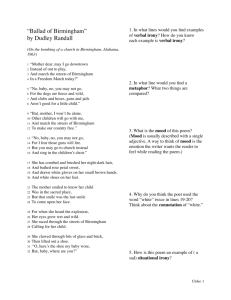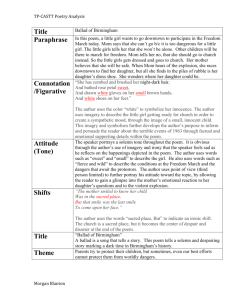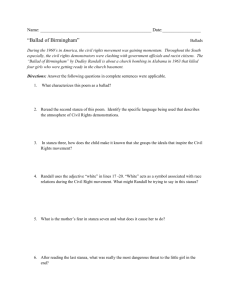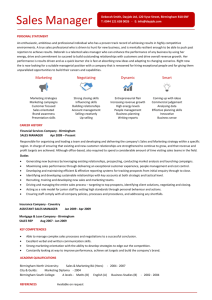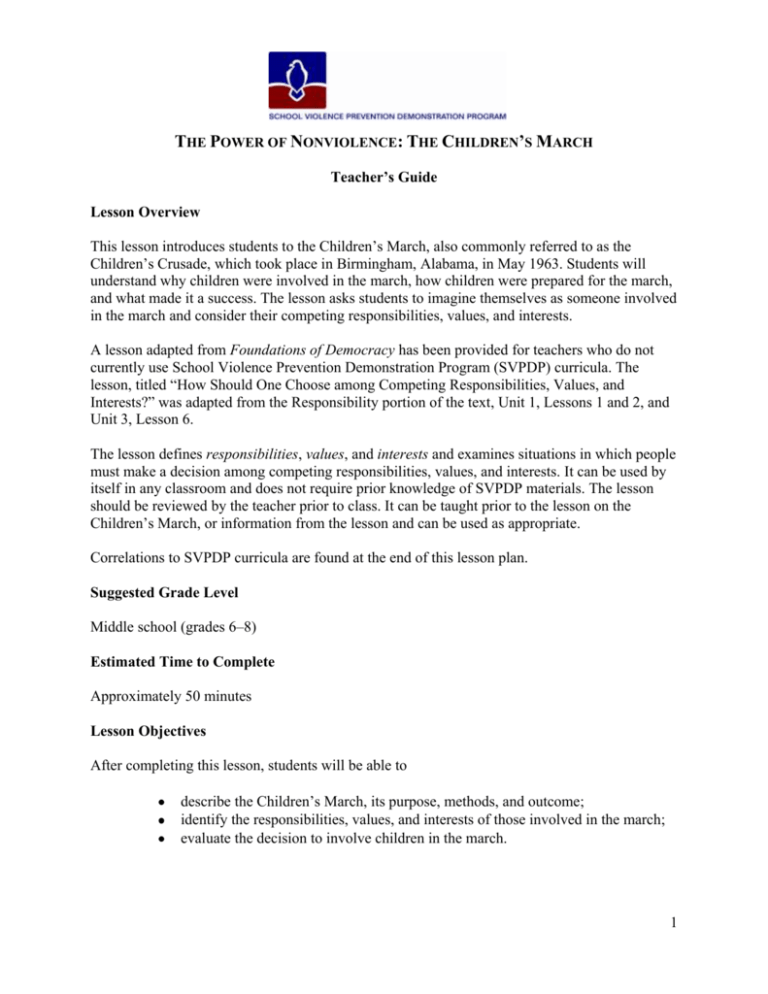
THE POWER OF NONVIOLENCE: THE CHILDREN’S MARCH
Teacher’s Guide
Lesson Overview
This lesson introduces students to the Children’s March, also commonly referred to as the
Children’s Crusade, which took place in Birmingham, Alabama, in May 1963. Students will
understand why children were involved in the march, how children were prepared for the march,
and what made it a success. The lesson asks students to imagine themselves as someone involved
in the march and consider their competing responsibilities, values, and interests.
A lesson adapted from Foundations of Democracy has been provided for teachers who do not
currently use School Violence Prevention Demonstration Program (SVPDP) curricula. The
lesson, titled “How Should One Choose among Competing Responsibilities, Values, and
Interests?” was adapted from the Responsibility portion of the text, Unit 1, Lessons 1 and 2, and
Unit 3, Lesson 6.
The lesson defines responsibilities, values, and interests and examines situations in which people
must make a decision among competing responsibilities, values, and interests. It can be used by
itself in any classroom and does not require prior knowledge of SVPDP materials. The lesson
should be reviewed by the teacher prior to class. It can be taught prior to the lesson on the
Children’s March, or information from the lesson and can be used as appropriate.
Correlations to SVPDP curricula are found at the end of this lesson plan.
Suggested Grade Level
Middle school (grades 6–8)
Estimated Time to Complete
Approximately 50 minutes
Lesson Objectives
After completing this lesson, students will be able to
describe the Children’s March, its purpose, methods, and outcome;
identify the responsibilities, values, and interests of those involved in the march;
evaluate the decision to involve children in the march.
1
Materials Needed
Student lesson: “How Should One Choose among Competing Responsibilities, Values,
and Interests?”
Teacher’s guide: “How Should One Choose among Competing Responsibilities, Values,
and Interests?”
Teacher resource: The Children’s Crusade of the Birmingham Civil Rights Campaign
“Ballad of Birmingham,” by Dudley Randall, 1965:
http://washingtonart.com/beltway/randall.html
The Children’s Crusade of the Birmingham Civil Rights Campaign (Handout 1)
Video: Janice Kelsey’s Story
Note-Taking Guide: Janice Kelsey’s Story (Handout 2)
Responsibilities, Values, and Interests Chart (Handout 3)
Before the Lesson
Review or teach “How Should One Choose among Competing Responsibilities, Values, and
Interests?”
Lesson Procedure
1. Beginning the lesson. Read Dudley Randall’s “Ballad of Birmingham.” Use the poem to
pique students’ interest in the events behind the poem. Ask students whether the poem
leaves them wondering about anything described or alluded to in the poem. Ask them if
they can connect the poem to anything they have heard or learned about in the past.
2. Reading about it. As a class, read the Children’s Crusade of the Birmingham Civil
Rights Campaign (Handout 1). Ask students to make connections between Handout 1
and the poem, “Ballad of Birmingham.”
3. Video viewing. Introduce the video, Janice Kelsey’s Story, by telling students that Kelsey
was a foot soldier in the Children’s Crusade. Have students watch and listen actively
using the Note-Taking Guide: Janice Kelsey’s Story (Handout 2).
Discuss students’ reactions to Kelsey’s story.
Discuss the outcome of the Children’s Crusade and what made this strategy
successful in Birmingham.
4. Group work. Have students work in small groups to identify the responsibilities, values,
and interests of the people listed below. Use the Responsibilities, Values, and Interests
Chart (Handout 3). Each group can select one of the bullet points below and present its
findings to the class. As an alternative, each member of a group can pretend to be of one
of the people listed below and act out their response with other members of their small
group.
2
A parent whose son or daughter wants to participate in the march
A student who wants to participate in the march
Martin Luther King Jr. and James Bevel, who organized the march
A teacher whose students walked out of class to march
A Birmingham store owner
Discuss students’ findings and the decision to involve children in the civil rights
movement.
5. Concluding the lesson. Discuss with the class the ways in which children today make a
difference in their communities.
Correlations to the SVPDP Curricula
Foundations of Democracy, middle school level
Authority:
Unit 1, Lesson 3
Unit 2, Lessons 6 and 7
Privacy:
Unit 4, Lesson 9
Responsibility :
Unit 3, Lessons 6 and 7
Unit 4, Lesson 11
Justice:
Unit 1, Lesson 1
Unit 2, Lesson 2
Unit 3, Lessons 6 and 7
Unit 4, Lessons 11 and 12
Foundations of Democracy, high school level
Authority:
Unit 1, Lesson 2
Unit 3, Lessons 6 and 7
Privacy:
Unit 4, Lesson 9
Responsibility:
Unit 3, Lessons 6 and 7
Unit 4, Lesson 11
Justice:
Unit 1, Lesson 1
Unit 2, Lesson 3
Unit 3, Lessons 6 and 7
Unit 4, Lessons 10 and 11
3
We the People: The Citizen & the Constitution, Level 2 (middle school)
Unit 1, concepts from Lesson 3
Unit 5, Lessons 23, 25, 26
Unit 6, Lessons 29 and 30
We the People: The Citizen & the Constitution, Level 3 (high school)
Unit 1, Lesson 2
Unit 5, Lesson 27
Unit 6, Lessons 33, 34, and 35
Project Citizen, Level 1 (middle school)
What Is Public Policy and Who Makes It?
Project Citizen, Level 2 (high school)
Chapter 1: Introduction to Project Citizen
Chapter 2: An Introduction to Public Policy
Chapter 4: Why Is Citizen Participation Important to Democracy?
This lesson was developed under a grant from the U.S. Department of Education. However, the contents do of this
lesson do not necessarily represent the policy of the Department of Education, and you should not assume endorsement
by the federal government.
© 2010, Center for Civic Education. All rights reserved. Permission is granted to freely reproduce and use this lesson
for nonprofit, classroom use only. Copyright must be acknowledged on all copies.
4

